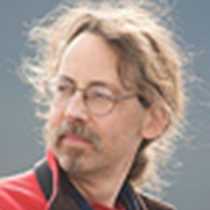Tracy Arm
We began our morning in Tracy Arm. Much of Southeast Alaska is made of accretionary bedrock, material that has been scraped off onto the American continent by the process of subduction. Deep within the Coast Range, igneous and metamorphic rocks predominate. These hard rocks are sculpted into particularly intense fjords like Tracy Arm. Vertical walls towered above our ship, deeply grooved by the glacier’s stony belly. Waterfalls tumbled down the steep sides of the valleys all around us.
After breakfast we stopped near Sawyer Glacier and boarded Zodiacs for a closer look at the ice. Sawyer Glacier is in catastrophic retreat, and so calves many bergs. The most impressive of these are from unusual submarine calvings. These areimpressive because ice at the base of a glacier is under pressure, with cracks and air bubbles squeezed out. The result is bergs of deep blue color. Moreover, ice at the glacier’s base is flexible, and so is not fractured into smallish pieces on its journey to the sea. We circled several huge blue bergs, marveling at the seemingly endless variety of forms and azure tones found in ice. As we motored about, we were ourselves being observed. Harbour seals frequent Tracy Arm to haul out on icebergs. Shy but curious, they often approached our boats, but dove the moment they knew we were aware of them.
At last we neared the glacier. At the end of the fjord a wall of ice towers two hundred feet above the water. Here we waited, hoping to see falling ice. We were not disappointed. A huge serac or ice pinnacle loosed and plunged into the sea. The wave that it created rocked our boats. A few minutes later, more ice began to fall. But suddenly a huge new berg appeared, this time from below. A submarine calving! The berg was so huge that it seemed to move in slow motion, rolling like a colossal hoary whale. And bergs tumbled from above! And another submarine berg rose! And more of the cliff face fragmented! All together a huge quantity of ice was loosened, from blue monsters the size of apartment blocks to tiny grey berglets. A great chaos of waves stirred our boats, and ice spread out in an amoebic jumble. In twenty years travelling to Alaska, this is the biggest calving I have ever seen.
In the afternoon, we travelled back down Tracy Arm, visiting a couple of impressive waterfalls. Cruising slowly through Stephen’s Passage, we shared the waters with several humpback whales.
Tracy Arm was something of a grand finale for us. But upon reflection, all of Southeast Alaska is a grand finale. In a place so extraordinary, everything seems to burst with grandeur. We have been lucky to share such a superlative part of the world.




